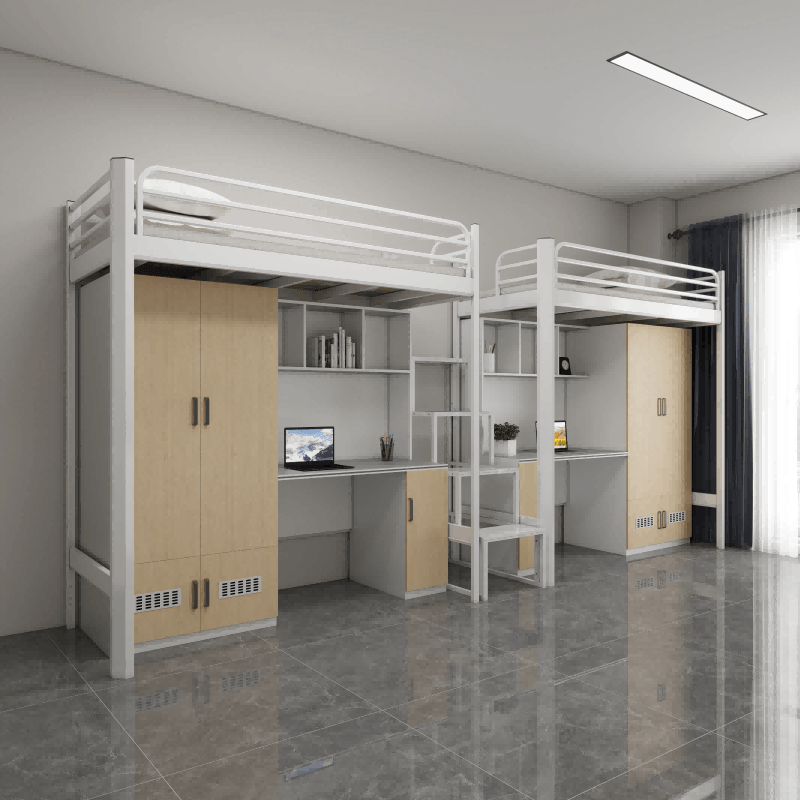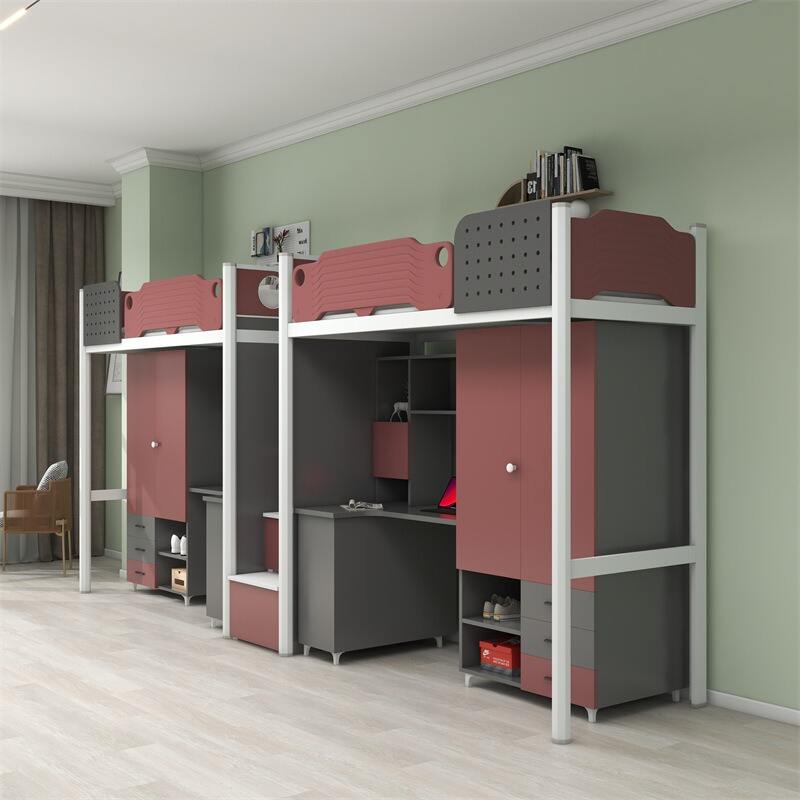Living in a dormitory presents unique challenges when it comes to creating a comfortable sleeping environment. Your dormitory bed serves as both your place of rest and often your primary personal space within the confines of shared living quarters. The quality of your sleep directly impacts your academic performance, mental health, and overall college experience. Unfortunately, standard dormitory beds are typically designed for durability and cost-effectiveness rather than comfort, leaving many students struggling with poor sleep quality throughout their academic years.

The transformation of your dormitory bed from a basic necessity into a comfortable sanctuary requires strategic planning and the right combination of bedding accessories, organizational solutions, and comfort enhancements. Many students underestimate the impact that proper bed setup can have on their daily routine, study habits, and overall well-being. By implementing proven comfort strategies, you can create an inviting sleep environment that rivals the comfort of your childhood bedroom while working within the constraints of dormitory regulations and limited space.
The investment in dormitory bed comfort pays dividends throughout your academic career. Quality sleep improves cognitive function, memory retention, and emotional regulation, all of which are crucial for academic success. Moreover, a comfortable dormitory bed provides a personal retreat where you can decompress from the social and academic pressures of college life. Understanding the fundamental elements of bed comfort and how to adapt them to the dormitory environment is essential for creating an optimal living experience during your college years.
Essential Bedding Upgrades for Maximum Comfort
Mattress Toppers and Padding Solutions
The foundation of any comfortable dormitory bed begins with addressing the typically firm and unsupportive mattress provided by most educational institutions. Memory foam mattress toppers represent one of the most effective solutions for transforming a basic dormitory mattress into a supportive sleeping surface. These toppers conform to your body's natural curves, reducing pressure points and promoting proper spinal alignment throughout the night.
When selecting a mattress topper for your dormitory bed, consider thickness options ranging from two to four inches, with thicker toppers providing more dramatic comfort improvements. Gel-infused memory foam toppers offer additional benefits by regulating temperature and preventing heat retention, which is particularly valuable in dormitories with limited climate control. Alternative options include latex toppers for those seeking more responsive support, or fiberfill toppers for students on tighter budgets who still want noticeable comfort improvements.
Installation and maintenance of mattress toppers in dormitory settings requires attention to practical considerations such as storage during breaks and compatibility with standard dormitory bed frames. Many toppers come with removable, washable covers that simplify maintenance and extend the product's lifespan. Consider investing in mattress topper anchors or straps to prevent shifting during sleep, ensuring consistent comfort throughout the night.
Premium Sheet Sets and Fabric Selection
The quality and type of sheets you choose significantly impact the comfort level of your dormitory bed. Thread count, while important, should be balanced with fiber quality and weave type to achieve optimal softness and durability. Cotton percale sheets offer breathability and crispness ideal for warmer dormitory environments, while cotton sateen provides silky smoothness and luxurious feel for those prioritizing comfort over temperature regulation.
Bamboo and microfiber alternatives present excellent options for students seeking hypoallergenic properties or easy-care fabrics that withstand frequent washing. Bamboo sheets naturally resist bacteria and odors while providing moisture-wicking properties, making them ideal for shared living spaces. Microfiber sheets offer affordability and wrinkle resistance, though they may retain heat more than natural fiber options.
Color and pattern selection should consider both personal preferences and practical dormitory living requirements. Darker colors and patterns hide stains and wear better than light colors, while neutral tones provide versatility in decorating and coordinate well with various dormitory color schemes. Investing in multiple sheet sets allows for regular rotation and washing, maintaining hygiene standards essential in dormitory environments.
Pillow Configuration and Support Systems
Proper pillow selection and arrangement create significant improvements in dormitory bed comfort and sleep quality. Your sleeping position determines the ideal pillow type and firmness level, with side sleepers requiring firmer, thicker pillows for neck support, while back and stomach sleepers benefit from thinner, softer options. Memory foam pillows provide consistent support and maintain their shape over time, making them excellent long-term investments for dormitory living.
Consider creating a pillow system that includes both sleeping pillows and support pillows for reading or studying in bed. Wedge pillows provide excellent back support for dormitory bed studying sessions, while body pillows offer additional comfort and can serve as makeshift seating for guests. Decorative pillows add personality to your dormitory bed while providing extra comfort options for various activities.
Pillow maintenance in dormitory settings requires attention to cleanliness and storage solutions. Pillow protectors extend pillow lifespan by preventing stains and allergen accumulation, while vacuum storage bags help manage pillow storage during academic breaks. Regular pillow replacement ensures optimal support and hygiene, with most pillows requiring replacement every one to two years depending on quality and usage patterns.
Space Optimization and Storage Integration
Under-Bed Storage Solutions
Maximizing storage space around your dormitory bed enhances both comfort and functionality while maintaining organization in limited square footage. Under-bed storage containers provide valuable space for seasonal clothing, extra bedding, and personal items while keeping your dormitory bed area clutter-free. Rolling storage bins offer easy access to stored items, while vacuum-sealed bags maximize space efficiency for bulky items like comforters and winter clothing.
Bed risers represent an excellent investment for creating additional under-bed storage space while improving dormitory bed accessibility. These simple devices elevate your bed frame by several inches, creating room for larger storage containers or even small furniture pieces like storage ottomans. When selecting bed risers, ensure compatibility with your specific dormitory bed frame and consider weight capacity to accommodate both the bed and stored items safely.
Organization systems within under-bed storage prevent items from becoming forgotten or inaccessible. Clear storage containers allow quick identification of contents, while labeled dividers keep similar items grouped together. Consider creating seasonal rotation systems where frequently used items remain easily accessible while seasonal items move to less convenient storage locations.
Bedside Organization and Accessibility
Creating accessible storage and organization around your dormitory bed improves daily convenience and maintains the peaceful atmosphere necessary for quality sleep. Bedside caddies that hang from the side of your dormitory bed provide convenient storage for books, electronics, water bottles, and other frequently used items without requiring floor space or additional furniture. These organizational tools keep essential items within arm's reach while maintaining a clean, uncluttered sleeping environment.
Over-door organizers maximize vertical space utilization around your dormitory bed area, providing additional storage for toiletries, school supplies, and personal items. Hanging shoe organizers repurpose effectively for storing everything from snacks and electronics to cleaning supplies and personal care items. These solutions work particularly well in dormitory settings where floor space is limited but wall and door space remain available for organization.
Lighting integration around your dormitory bed creates ambiance while providing functional illumination for reading and studying. Clip-on reading lights attach directly to bed frames or headboards, providing focused lighting without disturbing roommates. String lights add warmth and personality to your dormitory bed area while creating a relaxing atmosphere conducive to rest and relaxation.
Multi-Functional Furniture Integration
Selecting furniture pieces that serve multiple purposes maximizes functionality around your dormitory bed while conserving valuable floor space. Storage ottomans provide comfortable seating for guests while offering hidden storage for extra bedding, seasonal clothing, or personal items. These versatile pieces can also serve as makeshift desks or tables when needed, adapting to various dormitory living requirements throughout the day.
Folding or nesting tables create temporary workspace near your dormitory bed for studying, eating, or laptop use without requiring permanent floor space dedication. These portable solutions store easily when not in use and deploy quickly when needed for various activities. Look for lightweight options with smooth surfaces that clean easily and complement your overall dormitory bed aesthetic.
Wall-mounted shelving systems provide additional storage and display space around your dormitory bed without consuming floor area. Floating shelves accommodate books, decorative items, and frequently used supplies while maintaining clean lines that enhance rather than clutter your sleeping space. Modular shelving systems adapt to changing needs throughout the academic year and disassemble easily for transportation during moves.
Temperature and Environmental Control
Bedding Materials for Climate Management
Managing temperature and humidity around your dormitory bed significantly impacts sleep quality and overall comfort levels. Natural fiber bedding materials like cotton, linen, and bamboo offer superior breathability compared to synthetic alternatives, helping regulate body temperature throughout the night. Cotton percale weaves provide exceptional airflow, making them ideal for warm dormitory environments or students who tend to sleep hot.
Seasonal bedding rotation ensures optimal comfort year-round while adapting to changing dormitory heating and cooling conditions. Lightweight cotton or linen bedding works well during warmer months, while flannel sheets and heavier comforters provide necessary warmth during colder periods. Down alternative comforters offer excellent temperature regulation while remaining hypoallergenic and easy to care for in dormitory washing facilities.
Moisture-wicking mattress protectors and pillow covers help maintain a dry, comfortable sleeping environment while protecting your dormitory bed investments from spills and stains. These protective layers add minimal bulk while providing significant benefits in terms of hygiene and longevity. Waterproof options offer additional protection against accidents while remaining breathable enough for comfortable sleep.
Air Circulation and Ventilation Enhancement
Improving air circulation around your dormitory bed creates a more comfortable sleeping environment while reducing humidity and odor accumulation. Personal fans positioned strategically near your bed provide gentle airflow without disturbing roommates, while tower fans offer quiet operation and oscillating features for broader air circulation. USB-powered fans work well for students with limited electrical outlets near their dormitory bed.
Window treatment optimization balances privacy needs with natural ventilation requirements around your dormitory bed area. Adjustable blinds or curtains allow precise control over airflow while maintaining visual privacy when needed. Sheer curtains provide privacy during daylight hours while permitting air circulation, creating a comfortable environment for daytime rest or study sessions in your dormitory bed.
Air purification systems designed for small spaces improve air quality around your dormitory bed while reducing allergens and odors common in shared living environments. Compact HEPA air purifiers operate quietly enough for nighttime use while removing dust, pollen, and other airborne particles that can affect sleep quality. Essential oil diffusers provide aromatherapy benefits while adding pleasant scents that mask dormitory odors and create a more homelike atmosphere around your sleeping area.
Noise Reduction and Sound Management
Creating a quiet environment around your dormitory bed requires strategic approaches to sound management and noise reduction. White noise machines or apps provide consistent background sound that masks intermittent dormitory noises like hallway conversations, door slamming, and roommate activities. These devices help maintain sleep continuity while creating a more private acoustic environment within shared living spaces.
Soft furnishing additions around your dormitory bed area absorb sound and reduce echo, creating a quieter, more comfortable environment. Area rugs, tapestries, and fabric wall hangings add acoustic dampening while enhancing the visual appeal of your sleeping space. These items also provide additional insulation and warmth during colder months, contributing to overall comfort levels.
Earplugs and sleep headphones offer personal sound management solutions that don't require roommate coordination or dormitory modifications. High-quality foam earplugs provide effective noise reduction while remaining comfortable for extended wear. Sleep headphones allow you to listen to calming sounds, music, or audio content without disturbing others while blocking external noise that might interfere with rest.
Personalization and Aesthetic Enhancement
Color Coordination and Visual Appeal
Creating a cohesive color scheme around your dormitory bed transforms the space from institutional to personal while maintaining visual harmony within the larger room. Neutral base colors like white, gray, or beige provide versatility and longevity while allowing accent colors to be changed seasonally or as preferences evolve. These neutral foundations also coordinate well with most dormitory color schemes and roommate preferences.
Accent colors introduced through pillows, throws, and decorative elements allow personality expression without overwhelming the dormitory bed area or conflicting with roommate aesthetics. Coordinated color families create visual cohesion while multiple shades within the same color family add depth and interest. Consider the psychological effects of different colors, with blues and greens promoting relaxation while warmer tones create coziness and energy.
Textile layering adds visual richness and tactile comfort to your dormitory bed while providing practical benefits like additional warmth and softness. Combining different textures like smooth cotton sheets, soft fleece throws, and textured decorative pillows creates visual and tactile interest. This layering approach also allows easy seasonal transitions by adding or removing layers as temperature and comfort needs change.
Decorative Elements and Personal Touches
Incorporating meaningful decorative elements around your dormitory bed creates emotional comfort and connection to home while expressing individual personality within shared living spaces. Photo displays, artwork, and personal mementos transform sterile dormitory environments into welcoming, personalized spaces that support mental well-being and stress reduction. Choose lightweight, easily mountable options that won't damage walls or violate dormitory policies.
Lighting choices significantly impact the ambiance and functionality of your dormitory bed area. String lights create warm, cozy atmosphere while providing gentle illumination for evening activities. Adjustable desk lamps or clip-on reading lights offer task-specific lighting without disturbing roommates. Candles or flameless alternatives add aromatherapy benefits and romantic ambiance, though check dormitory fire safety regulations before using any flame-based lighting options.
Seasonal decoration rotation keeps your dormitory bed area fresh and engaging throughout the academic year while allowing creative expression and stress relief through decorating activities. Seasonal throws, pillow covers, and small decorative items provide easy ways to acknowledge holidays and changing seasons without major investment or storage requirements. These changes also provide opportunities to refresh and reorganize your dormitory bed area periodically.
Technology Integration and Modern Amenities
Thoughtful technology integration around your dormitory bed enhances convenience and functionality while maintaining the restful atmosphere necessary for quality sleep. Charging stations positioned within reach of your dormitory bed ensure electronic devices remain accessible while charging overnight. Wireless charging pads integrated into bedside areas eliminate cord clutter while providing convenient device charging during sleep hours.
Smart home devices scaled for dormitory living add modern convenience while respecting roommate privacy and dormitory regulations. Smart speakers provide music, alarms, and information services while remaining compact enough for limited dormitory bed space. Smart lighting systems allow customized illumination schedules and color temperatures that support natural sleep rhythms while providing convenient voice or app control.
Entertainment integration around your dormitory bed creates multi-functional space for relaxation, study, and social activities. Tablet or laptop stands allow comfortable viewing angles for streaming content or video calls while lying in bed. Portable projectors enable movie nights and presentations within your dormitory bed area, creating entertainment options that don't require common area access or roommate coordination.
FAQ
What type of mattress topper works best for a standard dormitory bed
Memory foam toppers between 2-4 inches thick provide the best balance of comfort improvement and practicality for most dormitory beds. Gel-infused options help with temperature regulation, while medium-firm toppers accommodate various sleeping positions. Look for toppers with removable, washable covers for easy maintenance in dormitory washing facilities.
How can I make my dormitory bed more comfortable without violating housing rules
Focus on additive improvements like quality bedding, mattress toppers, and organizational accessories that don't permanently modify the provided furniture. Most dormitories allow personal bedding, storage containers, and small furniture additions. Always check your specific housing contract for restrictions on modifications, electrical devices, and fire safety requirements.
What storage solutions work best around a dormitory bed in limited space
Under-bed storage containers, bed risers, hanging organizers, and multi-functional furniture provide maximum storage efficiency. Vacuum storage bags compress bulky items like comforters and seasonal clothing. Bedside caddies and over-door organizers utilize vertical space without requiring floor area. Choose stackable, modular options that adapt to changing needs throughout the academic year.
How do I maintain proper hygiene and cleanliness for my dormitory bed
Wash sheets and pillowcases weekly in hot water, rotate multiple sheet sets for consistent cleanliness, and use mattress and pillow protectors to prevent stains and allergen accumulation. Vacuum or shake out mattress toppers monthly, air out bedding regularly, and replace pillows annually. Keep personal items organized and clean shared surfaces regularly to maintain healthy sleeping environment.


